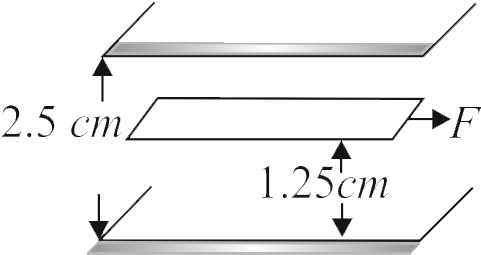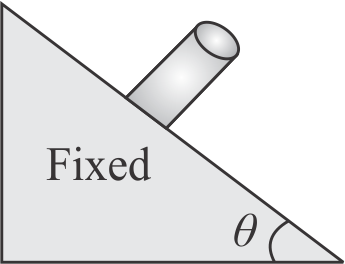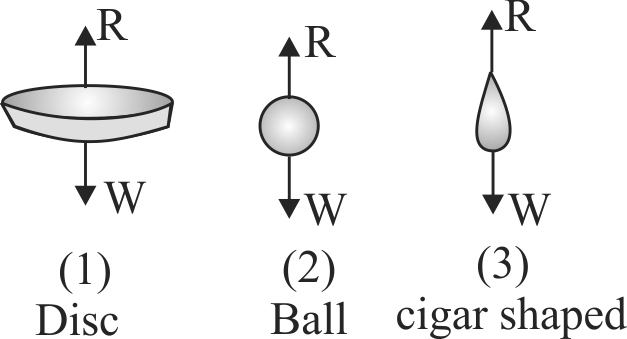361351 A square plate of \(0.1\;\,m\) side moves parallel to a second plate with a velocity of \(0.1\;m/s\), both plates being immersed in water. If the viscous force is \(0.002\,\;N\) and the coefficient of viscocity is 0.01 poise, distance between the plates in \(m\) is
361352
A space \(2.5\,cm\) wide between two large plane surfaces is filled with oil. Force required to drag a very thin plate of area \({0.5 {~m}^{2}}\) just midway the surfaces at a speed of \({0.5 {~m} / {s}}\) is \(1\,N.\) The coefficient of viscosity in \({{kg}-s / {m}^{2}}\) is
361353
A cylindrical vessel filled with water is released on an inclined surface of angle \(\theta\) as shown in figure.The friction coefficient of surface with the vessel is \(\mu \left( { < \tan \,\theta } \right).\) Then the contact angle made by the surface of water with the incline will be
361354
When a body falls in air, the resistance of air depends to a great extent on the shape of the body, 3 different shapes are given. Identify the combination of air resistances which truly represents the physical situation. (The cross sectional areas are the same).
361351 A square plate of \(0.1\;\,m\) side moves parallel to a second plate with a velocity of \(0.1\;m/s\), both plates being immersed in water. If the viscous force is \(0.002\,\;N\) and the coefficient of viscocity is 0.01 poise, distance between the plates in \(m\) is
361352
A space \(2.5\,cm\) wide between two large plane surfaces is filled with oil. Force required to drag a very thin plate of area \({0.5 {~m}^{2}}\) just midway the surfaces at a speed of \({0.5 {~m} / {s}}\) is \(1\,N.\) The coefficient of viscosity in \({{kg}-s / {m}^{2}}\) is
361353
A cylindrical vessel filled with water is released on an inclined surface of angle \(\theta\) as shown in figure.The friction coefficient of surface with the vessel is \(\mu \left( { < \tan \,\theta } \right).\) Then the contact angle made by the surface of water with the incline will be
361354
When a body falls in air, the resistance of air depends to a great extent on the shape of the body, 3 different shapes are given. Identify the combination of air resistances which truly represents the physical situation. (The cross sectional areas are the same).
361351 A square plate of \(0.1\;\,m\) side moves parallel to a second plate with a velocity of \(0.1\;m/s\), both plates being immersed in water. If the viscous force is \(0.002\,\;N\) and the coefficient of viscocity is 0.01 poise, distance between the plates in \(m\) is
361352
A space \(2.5\,cm\) wide between two large plane surfaces is filled with oil. Force required to drag a very thin plate of area \({0.5 {~m}^{2}}\) just midway the surfaces at a speed of \({0.5 {~m} / {s}}\) is \(1\,N.\) The coefficient of viscosity in \({{kg}-s / {m}^{2}}\) is
361353
A cylindrical vessel filled with water is released on an inclined surface of angle \(\theta\) as shown in figure.The friction coefficient of surface with the vessel is \(\mu \left( { < \tan \,\theta } \right).\) Then the contact angle made by the surface of water with the incline will be
361354
When a body falls in air, the resistance of air depends to a great extent on the shape of the body, 3 different shapes are given. Identify the combination of air resistances which truly represents the physical situation. (The cross sectional areas are the same).
361351 A square plate of \(0.1\;\,m\) side moves parallel to a second plate with a velocity of \(0.1\;m/s\), both plates being immersed in water. If the viscous force is \(0.002\,\;N\) and the coefficient of viscocity is 0.01 poise, distance between the plates in \(m\) is
361352
A space \(2.5\,cm\) wide between two large plane surfaces is filled with oil. Force required to drag a very thin plate of area \({0.5 {~m}^{2}}\) just midway the surfaces at a speed of \({0.5 {~m} / {s}}\) is \(1\,N.\) The coefficient of viscosity in \({{kg}-s / {m}^{2}}\) is
361353
A cylindrical vessel filled with water is released on an inclined surface of angle \(\theta\) as shown in figure.The friction coefficient of surface with the vessel is \(\mu \left( { < \tan \,\theta } \right).\) Then the contact angle made by the surface of water with the incline will be
361354
When a body falls in air, the resistance of air depends to a great extent on the shape of the body, 3 different shapes are given. Identify the combination of air resistances which truly represents the physical situation. (The cross sectional areas are the same).

